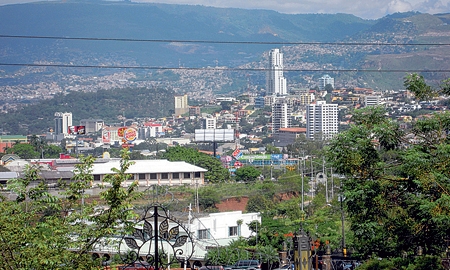Central America is a growing market for exports from the U.S., and the Central America-Dominican Republic-U.S. Free Trade Agreement (or CAFTA-DR, which came into force in 2006) and other FTAs have led to greater modernization and liberalization of the trade and investment regimes in Honduras.
Historically dependent on banana and coffee exports, Honduras has diversified its export base to now include apparel, automobile wire harnesses, cigars, gold, palm oil, fruit, lobster, shrimp and lumber. The U.S. is by far its greatest trading partner, accounting for 40% of Honduran exports and more than 44% of the republic’s imports.
The Honduran American Chamber of Commerce highlights various advantages Honduras has to offer international investors and traders. Examples include: political and social stability since 1980; legal and fiscal-friendly policies for investment; permanent tax exemption regimes; and ample availability of labor (unemployment is around 4.5% and approximately one-third of people are underemployed).
It also points out the country’s modern ports, some of which are certified by the International Maritime Organization; proximity to the U.S. enabling fast production and delivery times; availability of highly educated bilingual professionals; and abundant, high quality fertile lands.
“Certainly for me the biggest investment opportunities are in the agribusiness sector and foodstuffs,” says Miguel Alfonso Fernández Pérez, Vice-President of the Board at Banhcafé, a Honduran bank initially set up to serve the coffee industry that has expanded to support the nation’s small and medium-sized enterprises.
“We have many very fertile valleys and a privileged location in the tropics that, by geographical proximity, opens up access to niche markets of agricultural production.”
The Republic of Honduras is located right at the heart of Central America. Maritime access comes via various ports along its northern 415-mile Caribbean Sea shoreline and its shorter 101-mile Gulf of Fonseca coast on the Pacific side. It is served by four international airports – at the capital Tegucigalpa, La Ceiba, San Pedro Sula and Roatán – and it also has several major ports along its coasts. Puerto Cortés is Central America’s only deepwater port and is the first port in Latin America to qualify for both of the U.S. Government’s port security programs: the Container Security Initiative (CSI) and the Megaports Initiative.
“I would say to foreign investors that the entire Caribbean coast and beaches are ideal for investment in tourism,” adds Mr. Pérez. “Also Honduras is an important source of natural resources and everyone is talking about renewable energy.”
Electricity in Honduras is provided to the public by the state-owned
Empresa Nacional de Energía Eléctrica (ENEE), which also buys supplies from several independent power producers, such as Electricidad de Cortés (Elcosa) which operates the thermal plant at Puerto Cortés in the Sula Valley. Elcosa is a strategic alliance of Honduran investors and Finland’s renowned Wartsila that developed, built and has operated the first private thermoelectric plant in Honduras since 1994. Its operations substantially reduced the severe rationing of electricity that hit the country between 1994 and 1995.
“Since its inception, Elcosa has been a reference for the national and international private sector as to how attractive and secure investing in electric energy production in Honduras and throughout Central America can be,” says Salomón Ordóñez Soto, President of Elcosa. “Our company has also positioned itself as the leading pioneer in environmental issues and corporate social responsibility in the industry throughout Central America. We are the third largest producer of thermal energy and we are on track to becoming one of the three largest producers of electricity based on renewable sources.”
ENEE’s President Emil Hawit affirms that the renewable energy sector is ripe for foreign involvement, as the Government has committed to increasing the sector’s current 30% contribution to reduce susceptibility to external oil price shocks.
“We have advanced greatly, overcoming administrative obstacles that had long existed,” he says. “We have changed laws to receive any type of investor in the energy sector. Anyone with the willlingness to come and invest in Honduras can do so with complete confidence and security. We have laws that ensure the safety of investment in our country. ENEE also guarantees security through power-purchasing contracts that stipulate prices according to economic indicators such as inflation, fixed costs of equipment, tax incentives and exemptions.
“We base our contracts and regulations on international standards transparently. All our laws are accessible through our website and the company provides the facilities necessary for investment. We are clear that the way forward is with clean, renewable energy.”

0 COMMENTS